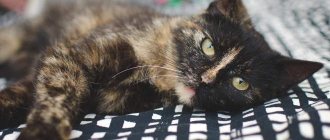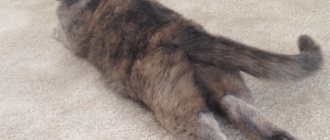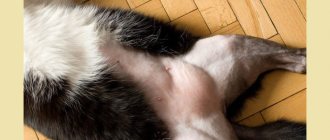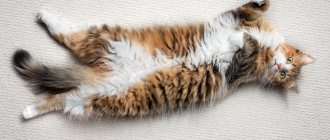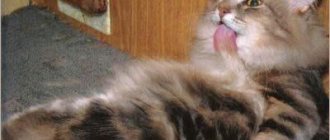16150Administration
1
If something is wrong with a pet’s health, it always causes serious concern for the owner. It is important to know the reasons why a cat’s hind legs fail and to imagine what measures need to be taken to restore the animal’s normal condition. In such a situation, you simply cannot do without a visit to the veterinarian.
Delay can often cost a cat’s life, which is why even a slight disturbance in gait, and even more so paralysis of the hind limbs, requires urgent treatment. The longer treatment is delayed, the higher the risk that the mobility of the paws will not be restored, or even that the pet will die.
© shutterstock
Causes
There are many reasons for problems with mobility in a cat, when its hind legs begin to move apart, fail, and even be taken away.
shutterstock
Now experts cite the following as the main factors that caused the cat to walk poorly:
- Advanced otodectosis - if the ear mite is not treated and the cat develops severe otitis media, over time the inflammation spreads to the brain, causing damage to its membranes. It leads to the appearance of various paralysis, and first of all, the hind legs lose normal mobility;
- Traumatic injuries to the spine - with this phenomenon, paralysis spreads to the hind legs and tail. The cat completely loses the ability to control the body, starting from the lower back, which causes serious disturbances not only in movement, but also in digestion;
- Lesions of the spinal cord that lead to necrosis of its tissues or severe compression of them - in this case, the cat’s hind legs are always taken away. This cause of the problem also includes cancer. Treatment at a time when paralysis has already begun is usually not effective, and the question of euthanizing the cat may be raised;
- Thromboembolism - with this disease, paralysis in the animal occurs sharply against the background of blockage of large vessels by a detached blood clot. This disease is very serious and in 95% of cases leads to the death of the animal within 36-72 hours following paralysis;
- Vitamin deficiency - when vitamin deficiency occurs in the animal’s body, all vital processes are disrupted, which changes the functioning of the ligaments and joints. In such a situation, weakness of the cat’s hind legs necessarily develops. The animal's movement is seriously impaired. The cat looks unkempt and walks, dragging its hind legs and noticeably wobbling its pelvis;
- Hip dysplasia - with this pathology, the development of the joint occurs incorrectly, due to which the muscles become significantly thinner and begin to negatively affect the hip, leading to chronic subluxation, which impairs the animal’s mobility. Often, due to the disease, the hind legs become bent, which causes the cat to move especially poorly;
- Stroke is a pathology that occurs not only in humans. The cat can also become a victim of cerebral hemorrhage. When a disease occurs, the cat receives brain damage, and if the motor center is affected, a loss of coordination of movement and mobility occurs, and first of all, the owner will notice that the cat’s hind legs have become tangled.
After the owner notices that the cat is afraid to stand on its hind legs, it is difficult for him to get up and sit down, and sometimes he even falls on his side when moving backwards, the pet must be urgently shown to a veterinarian on the day the violations are discovered. It is impossible to independently diagnose the cause of the problem and carry out high-quality therapy - only a doctor can tell you what to do and whether it is possible to cure the paws. If you delay the treatment, the animal’s condition can seriously deteriorate, which will pose a real threat to the pet’s life. Therapy must be started in a timely manner, and then the hind legs can still restore mobility, if not completely, then to a sufficient extent so that the cat does not suffer from the disorder.
Symptoms of pathology
Most often, limb paralysis does not occur immediately. First, signs of motor dysfunction appear, which is why the pet does not immediately lose control of its legs, but gradually. Veterinarians recommend not to hesitate to contact the clinic if the following symptoms appear:
- The cat begins to hesitantly step on the pads. Before he steps, he tries to find his balance.
- Dragging appears when the cat is unable to move its paws: it drags them without lifting them off the floor. It seems that the pet is sneaking up on the prey during the hunt. The next stage will be paralysis of the lower or lateral part of the body.
- The cat's limbs move greatly when walking or standing.
- Constant back squatting. This often occurs in older individuals over 10 years of age.
- Severe swelling in the pelvic cavity due to bites from dogs or other cats, trauma, problems with internal organs or the lower part of the spine.
- General loss of mobility even in a young animal. The cat prefers the opportunity to lie down and relax to games.
The appearance of one or more symptoms becomes a reason to contact a veterinary hospital. Delay in consultation may result in paralysis of part of the body.
The only non-dangerous situation is a wobbling gait in small kittens. This is a natural reason, it is explained by the weakness of muscle tissue at a young age. This goes away over time and does not require therapy.
Tick bites
Multiple bites from these insects are very dangerous for felines. The consequence of an encounter with an ixodid tick can be encephalitis, tularemia or other dangerous diseases. If your cat's back legs are weak, it is likely that she has tick paralysis. This disease often occurs in cases where an animal is attacked by several parasites at once. At first, your pet may be very agitated and even aggressive. Then this state is replaced by apathy. It is at this stage that paralysis of the limbs is possible, and if treatment is not started in time, the animal may die.
Causes of limb failure
There are several reasons for the loss of an animal's ability to actively move, some of them are related to the breed, some are not.
Thromboembolism
Blockage of an artery by a blood clot. As a result, the tissues to which it supplied blood are deprived of nutrition. With prolonged blockage of an artery by a thrombus, tissues deprived of nutrition become necrotic. The onset of this disease is acute. The animal screams loudly in pain and drags its paws when moving. When trying to probe the pelvic area, he snaps due to pain. Paws are cold, paw pads are bluish. The animal breathes frequently with an open mouth. Tachycardia develops, body temperature drops. The causes of thromboembolism are cardiomyopathies. If you do not help the animal within a few hours, it may die. With early, competent veterinary care, you can expect the ability to move independently to be restored.
Spinal cord injuries
This is a whole group of neurological pathologies of traumatic and non-traumatic origin. These may be spinal fractures with compression or rupture of the spinal cord. In this case, the limbs lose sensitivity, muscle tissue atrophies. Paresis and paralysis can be caused by herniated intervertebral discs, fibrocartilaginous embolism (FCE), and spinal cord tumors.
PCE is a sudden stroke followed by necrosis of spinal cord tissue due to embolization of the vessels feeding the brain tissue. The onset is acute, the animal screams in pain, then apathy develops. Paresis is most often unilateral.
Avitaminosis
Unbalanced food can cause the animal to lose its hind legs. With a deficiency of vitamin B1 (thiamine), the animal may develop paresis of the limbs, and sometimes paralysis. More often, vitamin deficiency occurs with an incorrectly formulated diet, if the animal eats natural food. The process is reversible. With timely treatment, the prognosis is quite favorable.
Potassium metabolism disorders
Lack of potassium in a cat's body can lead to weakness in its hind legs. Burmese cats are genetically predisposed to this pathology.
Nutritional hyperthyroidism
This is a metabolic disorder of an animal associated with an imbalance in its diet. As a result of insufficient intake of calcium from food, excess phosphorus and vitamin D deficiency, the pet’s body over-synthesizes parathyroid hormone. This is manifested by lameness, bloating, constipation. The animal's hind legs can literally move apart. Over time, the cat falls on its side, the bones become deformed, and convulsions begin.
Tick paralysis
This disease is fatal for cats if treatment is not started at the first symptoms. Caused by poisoning with toxins from an Ixodid tick bite. At first, the animal is excited, then apathy sets in, paresis of the limbs develops, tremors appear, and hypothermia develops. The cat's pupils are dilated, saliva containing foam appears from the mouth. In the end, the animal dies from laryngeal paralysis.
Spinal cord inflammation
Inflammatory processes in the tissues of the spinal cord (myelitis) can be caused by various infections, helminthiasis, poisoning, and autoimmune reactions provoked by injury. The cat's limbs fail, body temperature rises, the digestive system is disrupted, and urinary incontinence is possible. With timely treatment, restoration of motor functions is quite possible.
Hip dysplasia
Maine Coons and Chartreuse cats are prone to this pathology. This disease is not associated with paresis or paralysis. It is associated with improper development of the joint, as a result of which the cartilage tissue wears out and all movements cause severe pain to the animal. In this case, the cat moves with a meandering gait, stops jumping on stools, and may fall over on its side.
Arthrosis, arthritis
Such pathologies are also very common. The disease, as in the previous case, is characterized by the presence of degenerative-inflammatory processes in the joints. As a result of the destruction of the synovial cartilage of the articular capsules, the surfaces of the bones begin to “dry” rub against each other. This situation is accompanied by such severe pain that the animal tries not to move at all. In most cases, such pathologies are typical for older cats.
Treatment for arthritis is usually symptomatic. The furry patient is prescribed corticosteroids in combination with antimicrobial drugs. Sedatives are administered to reduce pain. In particularly advanced cases, surgery is prescribed.
Relaxation massage technique
You need to start the massage with circular movements along the spine.
With light, pleasant movements, you need to move in a spiral, massaging only with your fingertips. First the movements go clockwise, then counterclockwise. Gradually you need to increase the intensity of the pressure, depending on the pet’s behavior. The procedure is repeated up to 4 times.
Cats, like humans, also have acupuncture points that are connected to many organs. Exposure to them activates the work of these organs and the mechanism of action of protective forces is activated. From the back of the head to the sacrum you need to apply pressure with your thumbs.
Next, you can massage the head, starting from the base of the skull. Massage is performed with light circular movements of the fingertips. Gradually the pressure increases. Stroking and pressing should be pleasant, they will make the cat relax and go limp. Now you can move on to massaging the front of the neck, but the area of the pharynx and trachea should not be touched
In those places where the lymph nodes are located, you also need to massage with caution, avoiding strong pressure
Dysplasia
The symptoms of this disease are not very noticeable at first. The cat's paws seem to be tangled, it moves uncertainly, often stumbles, and limps. Over time, the animal begins to crawl. In this case, the paws clearly hurt, the animal hisses and shows aggression when trying to feel the limbs. The cause of hip dysplasia is a sedentary lifestyle, lack of vitamins and too much protein in the diet.
Treatment can be extremely drastic. The animal needs joint replacement surgery. The use of corticosteroids will help delay the inevitable. If the disease was detected at a very early stage, then most often you can do without a scalpel. The animal's limbs are fixed to reduce the load and anti-inflammatory injections are prescribed, as well as supplements with glucosamine and chondroetin.
Treatment methods
The choice of treatment method directly depends on the cause that led to the failure of the hind legs. To successfully rid a cat of this disease, owners must strictly follow the instructions of the attending physician.
Treatment methods for a cat that has lost its hind legs:
- Surgical intervention. Typically, surgery is performed on cats in the most extreme cases, when full recovery is impossible without it: for herniated intervertebral discs, spinal injuries, or, for example, severe dysplasia. If a cat is diagnosed with cancer, she is also prescribed drug and radiation therapy.
- Diet. The cat may need to be put on a special diet and provided with food that is rich in calcium, phosphorus and other nutrients.
- Drug therapy. Depending on what disease your cat has been diagnosed with, different medications may be prescribed. For example, antibiotics, antispasmodics, painkillers, anti-inflammatory drugs, anticoagulants, chondroprotectors.
- Creating a special environment in the house for the cat. For some diseases, for example, inflammation of the spinal cord, the cat must be placed in a dark, quiet place, protected from stress. In combination with drug therapy and physiotherapy, such an environment will contribute to a rapid recovery.
- Plaster application. In case of fractures, serious bruises, or to eliminate the consequences of dysplasia, a cast can be applied to the cat, which will fix the limb in the correct position and speed up the process of its recovery.
- Physiotherapy.
Physiotherapy procedures that a doctor may prescribe
The recovery period for a cat after failure of its hind legs can take a long time. To speed it up, doctors often prescribe daily physiotherapy for animals, which the owner can carry out together with the pet independently at home:
- Stimulating massage. It should be done for 10-15 minutes 5-7 times a day with intense but light movements. You should knead not only the paw pads, but also the limbs themselves. Massage helps restore the conduction of nerve impulses and protects muscles from atrophy.
- Using an inflatable ball. The cat must be placed with its stomach on a suitable-sized ball so that its paws lightly touch the floor. Then roll it back and forth, while carefully holding the pet. At the extreme points, it should seem to stand on its paws.
- Tickling paws. Helps the owner understand when sensitivity will return.
- Swimming. Gives excellent results if the cat is not afraid of water. It is necessary to fill the bathtub and hold the pet under the stomach so that it does not choke. In the water, the cat will instinctively begin to move its paws and try to swim.
- Physiotherapy. Gymnastics in the form of forced flexion and extension of the limbs, as well as exercises that resemble cycling, are very useful. This exercise must be done for at least 5 minutes a day.
- Walking simulation. You need to take the pet by the hind legs and slowly move them, imitating walking. To do this, you can use support in the form of a wide towel, which you need to pass under the cat's belly.
If the hind legs fail, cat owners should not despair. On the contrary, you need to take your pet to the veterinarian as soon as possible. Timely medical care, properly selected treatment and daily physiotherapeutic procedures in most cases allow cats to return to a full life over time.
I like1I don't like
Thromboembolism
This is another problem that may be indicated by the fact that the cat has lost its hind legs. From fear and pain, the animal screams and does not allow anyone to touch the sore limb, reacting aggressively even to its beloved owner. Over time, the paws become cold and completely paralyzed. The cause is blockage of the vessel by a blood clot that has broken away from the site of formation. This disease very often ends in the death of the animal, although an experienced doctor can fight for the life of a furry patient. Treatment consists of prescribing anticoagulants and physiotherapy.
Causes of limb failure
The occurrence of weakness in a cat's hind legs is caused by a large number of different factors. The main ones include hip dysplasia, hyperparathyroidism, thromboembolism, and inflammatory processes in the spinal cord.
Falls from great heights are often the cause of hind limb failure in cats. There is an opinion that representatives of the cat family perfectly group while jumping, landing on their paws. In fact, this is a myth that is far from the truth. Quite often in the practice of veterinarians there are cases of injuries to the spine, especially the sacral region in cats, resulting from a fall from a height.
When falling from a balcony, roof or tree, there is a high risk of damage to the lumbar spine, affecting the nerve endings responsible for the functioning of the hind limbs, tail and internal organs located in the back.
It is important to promptly determine the cause of lameness, as it can develop as a result of paralysis or a fracture of the cat’s hind leg. Treatment and diagnosis will differ significantly
Other causes of hind limb paralysis are:
- Intervertebral disc herniation. With this pathology, the intervertebral disc protrudes, causing the animal severe pain. Disc displacement between the vertebrae leads to compression of the nerve endings of the spinal cord and blood vessels. There is a disruption in the transmission of impulses along nerve fibers to the brain, necessary for the physiological functioning of the hind limbs.
- Thromboembolism. A disease characterized by the development of blood clots in the area of the femoral artery, blocking the lumen, disrupting blood flow and trophism of nearby tissue structures. An embolus, by its designation, is a solid, liquid or gaseous substrate inside a vessel that does not occur under normal conditions. An embolus can be a particle of a neoplasm, a parasitic microorganism, or a blood clot. If a cat drags its hind paw, experiences severe pain, and sensitivity decreases, then the chances of recovery are quite slim.
- Inflammatory processes in the spinal cord. Inflammation in the spinal cord can be triggered by infection of the body with worms, autoimmune diseases, and intoxication with heavy metal salts. The clinical picture of inflammation of the spinal cord is expressed by a sharp deterioration in the pet’s general condition, an increase in body temperature to high levels, dehydration and urinary incontinence.
- Stroke. Rarely occurring, but nevertheless giving serious consequences for the whole organism, is a pathological condition of the brain. As a result of hemorrhage and depending on the degree of vascular damage, paralysis of the hind limbs may develop in pets. Treatment of diagnosed stroke in cats involves taking immediate measures to stabilize the general condition of the body. In the absence of qualified assistance, the consequences are unusually severe, and death is also possible.
- Hyperparathyroidism of nutritional origin. Due to disturbances in metabolic processes in the body due to a lack of vitamin D and calcium, as well as as a result of increased phosphorus content, disturbances in the functioning of the parathyroid gland occur. Excessive amounts of parathyroid hormone are produced, and the gland itself works under increased load. In an animal with alimentary hyperparathyroidism, the bone structures are disturbed, the cat limps on its hind legs, convulsive phenomena are diagnosed, a shaky gait is detected, the paws move in different directions when walking. Timely diagnosis and treatment makes it possible to completely rid your pet of the disease.
Causes of limb failure in cats
There are many reasons for mobility impairment in cats. It is almost impossible to independently determine what the hind legs gave up. An accurate diagnosis and correct treatment can only be prescribed by a veterinarian, after conducting the necessary tests and a full examination of the cat. Failure of a cat's hind legs is a reason for urgent action.
Experts identify many reasons why a cat’s hind legs fail. The cat's movement may become impaired for the following reasons.
- Spinal injury in the lumbar region. It occurs more often in cats that roam freely on the street and may be hit by a car. There is also a high risk of such damage if the cat falls from a great height onto a hard surface. At home, spinal injury cannot be completely ruled out. With such an injury, in addition to the cat’s paws, the mobility of the tail is also impaired, since the lumbar spine, which is responsible for the mobility of the entire lower part of the body, is damaged. Possible general weakness.
- Thromboembolism. A dangerous condition that occurs due to blockage of the femoral artery by a blood clot. In such a situation, the cat experiences acute pain in the lumbar region and therefore begins to bite this place strongly. She also meows loudly due to pain. At first, the paws do not completely fail, and the cat only drags them when moving. Soon, as the tissues become necrotic, the paws become completely paralyzed and become cold. If help is not provided to the cat in the next 2 hours, then in most cases the cat dies within 2-3 days. If the pet has received the necessary therapy, then it is even possible to completely restore the mobility of the limbs. It is impossible to start treatment on your own.
- Spinal cord injury, traumatic and non-traumatic. With this disorder, the cat's paws are taken away and all sensitivity is lost. Gradually, if treatment is not started, the tissues begin to atrophy and completely lose their functions. Restoring paw mobility is not always possible, and in some cases the animal requires a stroller for normal movement. The device is attached to the animal in a special way, and the cat moves with its front paws, while the back of its body rides in a stroller. Hind legs raised.
- Tick paralysis. A very dangerous disease that leads to 100% mortality if treatment is not started within 24 hours after the first symptoms of the disease appear. Pathology occurs when a cat is bitten by ixodid ticks, which produce special substances that poison the cat’s body. At first, the animal behaves extremely excitedly. Then apathy develops and paralysis sets in, and the paws fail. The cat trembles and reacts poorly to external stimuli. There is a chance to save the cat only if you start treating it at the moment of excitement. If the paws fail, it’s too late.
- Inflammation of the spinal cord. Myelitis occurs due to infectious lesions, helminthic infestations, poisoning with heavy metal salts, injuries and autoimmune reactions. In such a situation, in addition to the fact that the paws fail, the cat experiences a general increase in temperature, urinary incontinence and digestive problems. If treatment begins immediately after the onset of symptoms of the disease, then restoring the mobility of the cat’s limbs is quite possible. In older animals, most often the restoration of mobility is not complete, but satisfactory.
- Hip dysplasia. Large, heavy animals such as Maine Coons and Chartreux cats are prone to this disease. With this pathology, a violation occurs in the development of the joint. As a result, the cat experiences severe pain when moving, which causes the pet’s gait to change. The cat walks, weaving and placing its hind legs uncertainly, and tries not to jump. If sick animals have to jump onto a bench or chair, they often fall over on their side and meow because of the acute pain that arises. Treatment is only supportive.
If problems arise with the limbs, the cat should be immediately shown to a veterinarian. The most possible diagnosis is trauma. You need to find out in detail how to treat a cat’s paws from a veterinarian. The causes of paralysis in cats are varied and the owner needs to know about the main ones.
There are many diseases that can cause loss of a cat's hind legs. There are many reasons for this, once you identify them, you can begin treatment. To do this, the veterinarian carries out laboratory and instrumental diagnostic methods and a general examination. The prescribed therapy should be strictly adhered to, and self-medication should not be resorted to, since paralysis is dangerous for the cat.
Paresis
If a cat's back paw is paralyzed after an injection, then one of the likely reasons may be the inept actions of the veterinarian or the person who performed the manipulation. The sciatic nerve may be damaged or a muscle may be injured.
Another reason could be the injection itself, or more precisely, the injection of “No-shpa” into the animal. This drug is not always suitable for cats. In some cases, it can cause paresis of the limbs.
Massage for a cat during constipation
Massage for cats with constipation is important and necessary along with a modified diet.
It is necessary to monitor how the cat goes to the toilet. Bowel movements should be performed at least once a day. For older animals, emptying once every 2-3 days is acceptable, but this condition can also be called a conditional norm, since metabolic processes slow down in older animals.
With irregular bowel movements, the body may be poisoned by decay products. The impact on the heart also increases, the load on organs such as the kidneys and liver increases, and the result is problematic coat. In addition to medications, a special diet, massage for cats will be useful for constipation.
This procedure is considered very effective for constipation and is effective, after just one session, usually the animal runs to the tray within a few minutes.
Massage movements help move stool through the intestines
It is important that the pet is relaxed before starting the procedure. It’s better to put him on your lap, lightly stroking him and talking quietly
Having seen that the animal has relaxed, you can move on to massage. The abdomen is massaged with your fingertips clockwise for about 5 minutes. Starting from the chest and moving towards the anus.
If the animal begins to get nervous, the procedure should be postponed and continued when it is calm.
Symptoms of paralysis of the limbs
Symptoms of the disease appear depending on the cause of paralysis.
- With inflammation of the spine and spinal cord, weakness in the limbs occurs with possible subsequent failure. The animal may have bloating, paralysis of the rectum and bladder. The cat may begin to lick and bite its back paws. When trying to move, he feels severe pain.
- Fibrocartilaginous embolism is characterized by sudden pain. The cat exhibits apathy, there is no sensitivity in the area of the hind legs and lower back. If the animal does not react to stimuli at all, the prognosis is unfavorable.
- Arterial thromboembolism complicates the work of the heart, causing its failure. When palpating the limbs, the cat feels pain. Cyanosis is visible on the paw pads, and the limbs become cold. The animal's breathing becomes heavier and shortness of breath appears.
- Fibrosis of the heart muscle at the initial stage practically does not manifest itself in anything other than numbness of the hind limbs. Subsequently, disturbances in heart rhythm and pulse are observed.
- After a stroke, the animal will have difficulty moving, falling on its side. The ability to eat, swallow and even breathe normally is complicated. In some cases, the cat will be in a state of shock and not respond to stimuli.
With any of these diseases, you may notice the following signs in your kitten:
- the gait becomes wagging with the hind legs affected;
- the animal moves slowly and uncertainly, as if drunk;
- the hind legs move apart;
- frequent squatting on the hind legs;
- dragging the paws without lifting them off the floor.
A symptom of paralysis in cats can be dragging their paws without lifting them off the floor.
If you notice at least one of the symptoms, immediately contact a clinic or private veterinary office. Inaction or delayed treatment can cost the animal its health, and possibly its life.
Cardiomyopathy, stroke
An increase in the volume of the heart or thickening of its walls (cardiomyopathy) sharply leads to paralysis of the limbs. But this still happens. The cause is a lack of oxygen reaching the muscles. Associated symptoms of the disease are shortness of breath, drowsiness of the animal, cough, and apathetic state. Since heart surgery cannot be performed on cats, treatment will be conservative. Veterinarians often prescribe Diltiazem or Atenolol, and complete rest is recommended for the animal.
Sometimes the cause of limb paralysis is a stroke. It often occurs in old or sedentary animals. Treatment is possible only with the assistance of an experienced veterinarian. He will prescribe antipsychotics, painkillers and anti-convulsions medications.
Diagnosis of the disease
Seizures in a cat: causes, what to do, treatment
To determine the cause of the pathological process, the following laboratory tests are prescribed:
- general clinical analysis of blood and urine;
- blood biochemistry;
- bacteriological culture of blood, urine, cerebrospinal fluid;
- ELISA, PCR studies to determine the virus;
- blood test for microelement and vitamin composition.
Examination by a doctor
Based on the symptoms that appear, the doctor prescribes any of these instrumental examinations;
- x-ray of bones;
- Ultrasound of the abdominal organs;
- CT, MRI to determine the structure of the brain and torso layer by layer;
- measurement of intracranial pressure;
- contrast study of blood vessels:
- Ultrasound of the heart, blood pressure measurement.
If the limbs fail and the animal is unable to stand or sit down, an X-ray is a mandatory examination.
Kidney failure, vitamin deficiency
So, you noticed that the cat has lost its hind legs. What to do in this case? One of the most harmless causes of this condition is vitamin deficiency. It often affects young animals or lactating females. Sometimes the cause of vitamin deficiency lies in the presence of helminths. In the presence of parasites, nutrients simply do not have time to be absorbed into the blood in sufficient quantities. Vitamin deficiency and disturbance of intestinal flora are also possible after an infectious disease suffered by an animal, long-term use of antibiotics, or for some other reasons. This problem can almost always be solved; you just need to review your pet’s diet and ensure a sufficient supply of vitamins.
If a cat's hind legs are lost, the causes and treatment should be determined by a veterinarian. For example, one possibility could be kidney failure. In this case, the animal is prescribed a special diet with a low protein content, B vitamins and steroid medications. The main symptoms are:
- poor appetite;
- complete refusal to eat;
- apathy;
- vomit;
- diarrhea;
- lethargy;
- decreased intensity of urination or its complete absence;
- elevated temperature.

